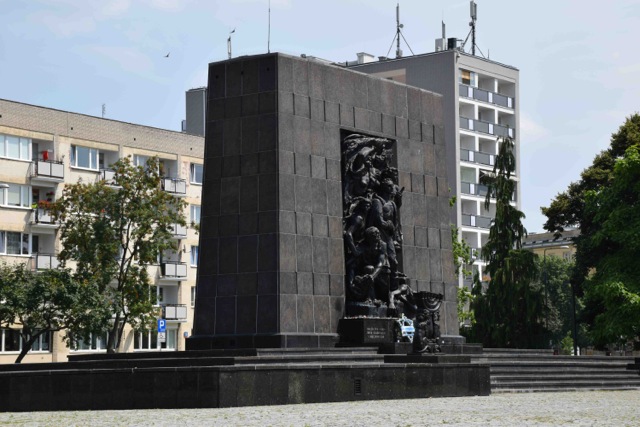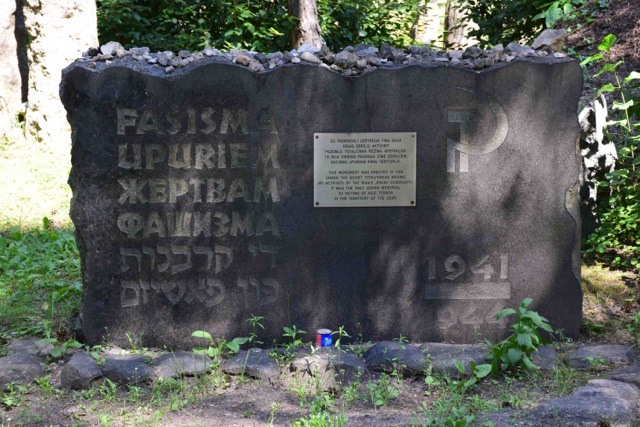The Europeanization of Holocaust memory in Eastern Europe
by Marek Kucia, Jagiellonian University, Poland
How did the memory of the Holocaust in Eastern Europe become transformed in the process of Europeanization? Before trying to answer this question, I have to explain what I mean by “the Holocaust,” “memory,” and “Eastern Europe.” The concept of Eastern Europe emerged from the aftermath of the Second World War, and communist reality played a key role in shaping the memory of the Holocaust. The memory of the Holocaust as we currently understand it did not appear immediately, but rather developed globally. The reintegration of Eastern Europe into Europe transformed the memory of the Holocaust in the region, and I shall identify the key agents of this change and the main outcomes of the process.
By the “Holocaust,” I mean the persecution and murder of Jews by Nazi Germany, its allies, and collaborators during the Second World War. This definition draws upon the definition used by the United States Holocaust Memorial Museum. It identifies the Jews as victims and Nazi Germany as the major perpetrator. It also highlights the complicity of some other states and individuals in the Holocaust crimes, which is important in the East European context. “Memory” will here mean beliefs, practices, and objects relating to the past that are characteristic of a group of people rather than individuals. This definition that stresses the social refers to the classic concept of “collective memory” outlined by the French sociologist Maurice Halbwachs, and the idea of the sociology of mnemonic practices and their products developed by the contemporary American memory scholar Jeffrey K. Olick. “Eastern Europe” is the part of Europe that was ruled by the communists for much of the 20th century, which underwent post-communist transition after the demise of communism in 1989–91, building democracy and free markets, and whose countries have been in various relations with the European Union (EU), ranging from association, through candidacy, to membership. Most importantly, “Eastern Europe” is the area where the Holocaust largely took place in mass executions, ghettos, and death camps, as stressed recently by Timothy Snyder in his book Black Earth: The Holocaust as History and Warning (2015). These are also the countries whose Jews were the vast majority (95 per cent) of the Holocaust victims, as follows from the data compiled by the historian Lucy S. Dawidowicz in her classic The War against the Jews: 1933–1945 (1986).
At present, the region of Eastern Europe defined through the Holocaust, communism, post-communist transition, and relations with the European Union (EU) comprises twenty states: (a) six former satellites of the Soviet Union, Bulgaria, the Czech Republic, Hungary, Poland, Romania, and Slovakia; (b) six former Soviet republics, Belarus, Estonia, Latvia, Lithuania, Moldova, and Ukraine; (c) seven successor states of communist Yugoslavia, Bosnia and Herzegovina, Croatia, Kosovo, (the former Yugoslav Republic of) Macedonia, Montenegro, Serbia, and Slovenia; and (d) Albania. I am deliberately excluding two other countries from my analysis—the former German Democratic Republic and the present Russian Federation. These countries constitute different cases for the analysis of the Holocaust and its memory.
After the Second World War, the persecution and murder of the Jews was first not distinguished among the atrocities committed by Nazi Germany. In most of the world, what later became called the Holocaust fell into historical oblivion. In the 1950s, ‘60s, ‘70s, and ‘80s national memories of the Holocaust began developing in Israel, (West) Germany, the USA, and other countries of the free world. Since the 1990s, the national Holocaust memories were supplemented by a new development—global or cosmopolitan Holocaust memory, as discussed by Jeffrey C. Alexander in his article “On the Social Construction of Moral Universals: The ‘Holocaust’ from War Crime to Trauma Drama” (2002), and Daniel Levy and Nathan Sznaider in their article “Memory Unbound: The Holocaust and the Formation of Cosmopolitan Memory” (2002).

The Monument to the Ghetto Heroes, Warsaw (1948). Photograph: M. Kucia, 2014.
Meanwhile, in communist-ruled Eastern Europe, there was little, hardly any, or no memory of the Holocaust. Let me consider memorials to illustrate this statement. It is a fact that some outstanding and explicit Holocaust memorials were erected in some places in the region, notably the Monument to the Ghetto Heroes in Warsaw (1948) and the Memorial at the former death camp of Treblinka (1964). In some Holocaust sites, the communist authorities created, or allowed the remnant Jews to create, memorials; but these sites universalized or nationalized the murdered Jews, referring to them either as “victims” or “citizens,” respectively. Examples included the memorial in the Rumbula forest near Riga (1964) and the “International Monument to the Victims of Fascism” in the former Auschwitz-Birkenau camp. The vast majority of the sites of the Holocaust, however, were not commemorated at all. The situation began to change following the demise of communism, and this is when Holocaust memory developed in Eastern Europe. The Europeanization of Holocaust memory was one the factors that contributed to this development.

The Monument in the Rumbula Forest (1964). Photograph: M. Kucia, 2014.
“Europeanization” is commonly understood as the growth of a European polity and identity over and above national polities and identities on the continent of Europe in the course of the development of the European Union. The institutions of the EU are considered to be the major agents of this process. Since the early 1990s, this process has also included the development of a European memory of the Holocaust. This is what I refer to as the “Europeanization of Holocaust memory.” When that process was unfolding, it concerned the then EU member states and the countries of Eastern Europe that initially aspired to join the EU and eventually became the union’s members.
The EU institution that played the key role in the Europeanization of Holocaust memory is the European Parliament (EP). Between the early 1990s, when the process began, and 2004, when the first eight East European countries joined the EU, the EP adopted seven legally non-binding but politically significant documents—resolutions and declarations—dealing with various matters related to the Holocaust. After the first wave of Eastern enlargement, the EP adopted five more Holocaust-related documents. The matter that featured in most of them was the idea of “an annual European Day of Remembrance of the Holocaust to be instituted in all the Member States of the Union.” The EP indicated that January 27, the day on which the Auschwitz camp—a symbol, for many the symbol of the Holocaust—was liberated in 1945, would be that day. As the idea of a Holocaust remembrance day and the entire process of Europeanization of Holocaust memory became prominent in the EU during the preparation for Eastern enlargement, the EU assumed that the prospective new member states from the East would also institute a Holocaust remembrance day and would develop other aspects of Holocaust memory.
While the EP was Europeanizing Holocaust memory within the EU and the process was reaching out to Eastern Europe, in 1998 Sweden, a EU member since 1995, initiated the Task Force for International Cooperation on Holocaust Education, Remembrance, and Research (ITF), now called the International Holocaust Remembrance Alliance (IHRA). This organization, joined by many old EU member states such as Germany, France, and the United Kingdom as well as Israel and the USA, became the major agent promoting Holocaust memory among its member countries and beyond. It also became a major agent of the Europeanization of Holocaust memory in Eastern Europe. Membership in the ITF/IHRA may be considered as an indicator of this process. By early 2016, the organization has 31 member countries, 11 of them from Eastern Europe—Poland since 1999; the Czech Republic, Hungary, and Lithuania since 2002; Latvia and Romania since 2004; Croatia and Slovakia since 2005; Estonia since 2007; Serbia and Slovenia since 2011. Four other East European countries declared their intentions to join the IHRA—Macedonia in 2009, Bulgaria in 2012, and Albania and Moldova in 2014. Thus, only five countries of the region—Belarus, Bosnia and Herzegovina, Kosovo, Montenegro, and Ukraine—have so far not been involved.
As a result, Holocaust remembrance days and Holocaust memorials were instituted throughout the region. January 27, which was advocated by the EP and later also by the United Nations as international Holocaust remembrance day, was legislated in four out of 11 East European member states of the EU—Estonia (2002), Croatia (2003), the Czech Republic (2004), and Slovenia (2008), and was also instituted in two other countries of the region that are not EU members but aspire to join, Albania (2004) and Ukraine (2011). Five East European EU member states chose different days reflecting significant events related to the Holocaust that took place in those countries. Latvia chose July 4, the day in 1941 when Jews were burned alive in a synagogue in Riga, and has commemorated this day since 1990. In 1994, Lithuania instituted September 23, marking the liquidation of the ghetto of Vilnius in 1943. In 2000, Hungary legislated April 16, the day in 1944 of the establishment of the first ghetto in wartime Hungary (in Munkács – Мукачеве in present-day Ukraine), and the start of the deportation of Hungarian Jewry. Since 2002, Bulgaria has observed March 10, the day in 1943 when the government and the public of the country prevented the deportations of its Jews. In 2004, Romania instituted October 9, marking the beginning of deportations of Jews to Transnistria by the Romanian authorities in 1941. In 2011, (the Former Yugoslav Republic of) Macedonia, a EU candidate, legislated March 11, the day in 1943 when the country’s Jews were deported to the death camp of Treblinka. Two other East European member states of the EU—Poland and Slovakia—and one EU candidate—Serbia—observe both January 27 and a day of national Holocaust significance. Poland has commemorated January 27 and April 19, the day in 1943 when the Warsaw Ghetto Uprising broke out, since 1946. These days were legislated as official Holocaust Remembrance Days in 2004 and 2005, respectively, following the Council of Europe’s and the UN’s decisions. Since 2000 Slovakia has celebrated September 9, the day in 1941 when the anti-Jewish laws were adopted by the wartime government of the country. Since 1992, Serbia has observed April 22, the day in 1945 when a group of inmates attempted to break out of the Ustaše-operated Jasenovac concentration camp in Croatia. In 2006 it legislated January 27.

The Monument in Bełżec (2004). Photograph: M. Kucia, 2014.
As for Holocaust memorials (and also museums and exhibits), there has been a remarkable development of these forms of Holocaust memory in Eastern Europe. Examples include new plaques (replacing the old ones) by the International Monument in Auschwitz-Birkenau that stress that the majority of the camp’s victims were Jews (1994), the new monument on the site of the former death camp in Bełżec (2002–2004), new memorial objects added to the old one in the Rumbula forest by Riga (2002–2005), and the new Holocaust memorial in Bucharest (2009).
The Holocaust Memorial in Bucharest (2009). Photograph: M. Kucia, 2014.
The many developments of Holocaust memory in Eastern Europe in the 1990s, 2000s, and beyond were brought about by various agents as part of larger processes. The EU through its parliament and the ITF/IHRA were among the key agents, and the Europeanization of Holocaust memory was one of the main processes.
The author gave the Skalny Public Lecture at the University of Rochester on the topic of this article on April 5, 2016.
An extended version of this article appeared as “The Europeanization of Holocaust Memory and Eastern Europe” in East European Politics & Societies, 2016, 30 (1): 97–119, doi:10.1177/0888325415599195.
Research leading to this work has been supported by the European Union under a Marie Curie Research Training Network, FP7-PEOPLE-2012-IEF, Grant No. 330424, EurHolMem.
Dr. Marek Kucia was visiting professor in the Skalny Center in Spring 2016. He is associate professor at the Institute of Sociology and lecturer at the Centre for European Studies Jagiellonian University, Kraków, Poland.
